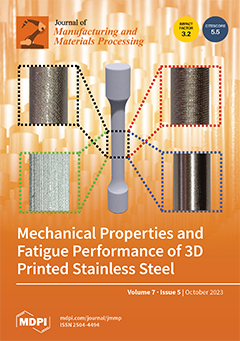This study presents a comprehensive investigation and modeling of the ignition delay time (
) in wire-EDM (WEDM). The research focuses on the influence of gap distance, discharge energy, and piece height on the stochastic distributions of
, providing
[...] Read more.
This study presents a comprehensive investigation and modeling of the ignition delay time (
) in wire-EDM (WEDM). The research focuses on the influence of gap distance, discharge energy, and piece height on the stochastic distributions of
, providing important insights into the complex properties of these distributions. Observations indicate that these parameters exert significant yet intricate influences on
, with a particular emphasis on the gap distance. A critical value was identified, around
to
, that divides the stochastic behavior. To capture the binomial nature of
, a mixture probability model consisting of two Weibull distribution curves was developed and validated through extensive experimentation and a data analysis. The model demonstrated strong agreement with observed cumulative probability curves, indicating its accuracy and reliability in predicting
. Further, a sensitivity analysis revealed regions of fast change, emphasizing the challenges and importance of careful parameter selection in control of WEDM processes. The findings of this study contribute to a deeper understanding of WEDM processes and provide a modeling approach for predicting
. Future research directions include refining the model by incorporating additional input parameters, investigating the influence of other process variables on
.
Full article





